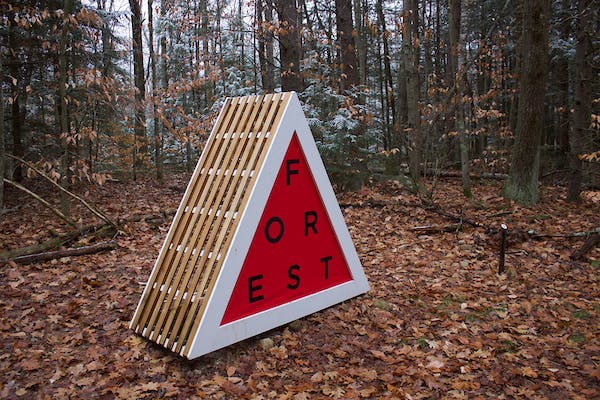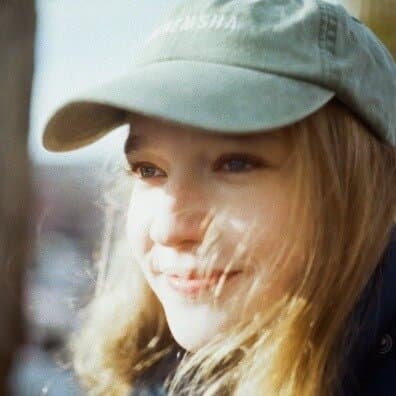It was one of those disorientingly verdant days when we made the trek from Boston to the Harvard Forest in nearby Petersham. The warm wind made the previous endless winter a faint memory. David Buckley Borden, the recipient of the year-long Charles Bullard Fellowship in Forest Research, greeted us at the entrance to the Fitchburg Museum, which doubles as the entry to the forest research center. “I’m glad to see you’re wearing long sleeves,” he joked. “The mosquitos might have chased you out of the forest otherwise.”
Borden is a landscape architect, interdisciplinary artist, and designer who has partnered with Aaron Ellison, Senior Research Ecologist at the Harvard Forest, and several other artists to create “Hemlock Hospice.” The project, which has been in progress for nearly a year, involves several forms of representative science-communications. Site-immersive installations, lectures, research, and multimedia art are all centered around charting the demise of the eastern hemlock, and the simultaneous rise of the hemlock wooly adelgid—a deeply complex relationship that will leave the eastern hemlock essentially extinct by 2025.
As we walked along the well trodden lines of the “Hemlock Hospice” interpretive trail, Borden and Ellison were mindful of the habitat beneath their feet. Despite stemming from very different career paths, their collaboration within the Harvard Forest was a natural fit. The two men share an affinity for one another that was evident from our first few moments together. In a back and forth manner, they explained how the project took root. Ellison initially encouraged Borden to apply for a fellowship. It was an unusual plea for a grant that is historically rewarded to career scientists for structured research, but Ellison saw an opportunity to expand the Forest’s sphere of influence to people beyond the hard science community. Together, they saw a chance to play with the divisions between research science communication and responsive art.
The Harvard Forest is often referred to as “The Wired Forest” for its expansive data collection systems, wide-ranging Internet connectivity, and several viewing towers. Prior to applying to the fellowship, Borden spent several months workshopping an appropriately scientific art proposal. Struck by the the juxtaposition of wild woodlands and high level research, Borden landed on a project that would naturally combine the natural phenomena of the environment with the prevailing research at hand. During the first two months of the fellowship, Borden created very little, instead versing himself in the dynamics of the forest. Working closely with Ellison, they began to create a narrative about the wave of death occurring right in front of them. With little time left to mourn, Borden created the “Hemlock Hospice” as a space to simultaneously grieve, learn, and effect change.
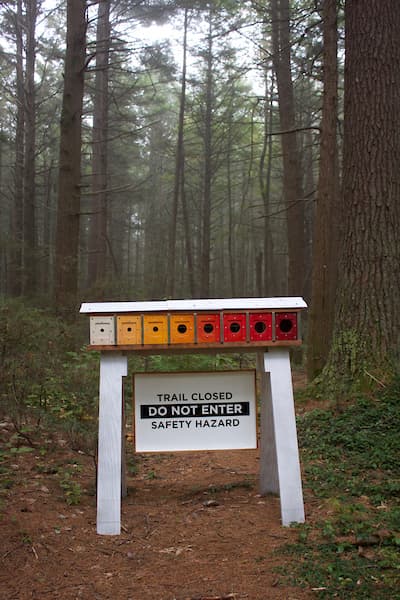
“Wayfinding Barrier, No. 2,” installation at Harvard Forest, measuring 1 x 3.5 x 4 feet, and made from wood, acrylic paint, vinyl, hardware, aluminum tape, and recycled ant nests, 2017. Collaborators: David Buckley Borden, Jack Byers, Aaron Ellison, and Salua Rivero.
Through 18 sculptural works along a two mile long path, Borden, Ellison and 13 contributing artists tell the story of the hemlock, teaching us how to grieve and grapple with our complicity in rising temperatures and the resulting rise of the tree’s killers, the hemlock wooly adelgid (HWA). The story is in plain sight, with bloated, graying hemlock trees experiencing their last moments of verticality everywhere you look, but who’s to blame is less clear.
“We call it ‘Hemlock Hospice’ not because we’re trying to save the trees, but because in many respects there is no saving the trees. Hospice care, from the human analogy, is not just for the dying, but also for the living. People can come to the passing of a loved one, whether it be a tree or species or human, in a positive way that gives time to reconcile with this passing.”
The installation is far more than site-specific—rather it is site-responsive and constantly attuned to the contingencies involved in working within a dynamic environment. While the entire series relies on symbolism to conceptually reflect its surroundings, at least 90 percent of the elements and materials used are culled from the Harvard Forest. According to contributing visual artist Jack Byers, the recycled materials were pivotal to Borden’s creative process. “The waste material from the Harvard Forest property created an important design constraint,” Byers said. “By limiting our options, it gave shape to the project and also kept it relevant to the Harvard Forest.”
“Trail Closed. Do Not Enter. Safety Hazard,” a sign reads. The first piece along the trail is especially jarring, quickly orienting us to the dire situation at hand. Above the sign, a clearing in the forest canopy where several hemlocks once stood lets in a stream of sunlight that beams directly onto the signage. The absence, in an otherwise lush environment, felt suddenly palpable.
The story of the hemlock’s demise is directly linked to globalization. It is believed that the hemlock wooly adelgid arrived in the late 1950s on a piece of decorative Japanese wood. The small, aphid-like, bug has since spread across 18 states, destroying several hemlock-dense forests in its wake. Deemed an invasive species, the HWA highlights questions of environmental agency and human values. The fact of the matter is that the adelgid didn’t deliberately choose to come here, it was brought to the U.S. mistakenly by way of naïve vanity and cross cultural exchange. The adelgid in turn found a source of shelter and food in the hemlock, and continued to do what it was genetically programmed to do. Nature, even in the form of a tiny invasive insect, does not have the capacity to understand human concerns of extinction.
Borden points us toward Double Assault, a piece that directly addresses the confluence of factors contributing to the HWA’s rise; the red of the vintage saw represents rising temperatures against the simple outline of an adelgid. On the trail guide, Borden writes, “Winter lows of -25 celcius historically prevented the HWA from migrating north, but as winter temperatures gradually rise, the insect spreads in tandem.” To combat this, several chemical solutions have been tested to protect the hemlocks from the adelgid, but none have acheived lasting success. While cold weather can naturally limit the insects’ reproduction for the winter months, the warming temperatures of climate change have expedited their domination year round. Alas, there is no cure; so “Hemlock Hospice” reckons with this fatal diagnosis.
Even though there is room for empathy towards the agent of hemlock destruction, there must also be space to simply mourn. As we move along the trail, Black Armband Ecology is spotted wrapped around a dying hemlock, publicly commemorating the deceased all while sporting the Harvard Forest insignia.
While one of the simplest pieces in design, the Hemlock Memorial Shed, is perhaps the most evocative. Paneled wood surrounds a hemlock recently killed by the HWA. As Ellison explained, when the insects attack a hemlock, it becomes a sponge, soaking up water that is unable to circulate. When the trunks become hollowed and porous, they eventually snap, crashing dramatically to the forest floor: hence Widow Makers.
Woven and white, the roof of the Hemlock Memorial Shed, creates a golden hue around the departed tree, a scene of destruction Borden meticulously left untouched. The inspiration for this powerful framing came from the 1930s era dioramas in the Fisher Museum at the Harvard forest chronicling New England’s forest history. In the early phases of “Hemlock Hospice,” one of the questions Borden kept returning to is: how do we create the diorama of the future? This, he thinks, is it.
In the presence of the Memorial Shed, it is difficult not to feel a wave of guilt. The broken trunk and withered roots feel like a small representation of how humans from generations past, present, and future are impacting the entire planet. Yet, what the “Hemlock Hospice” is trying to teach us, is not how to save the hemlock, but rather how to employ empathy, act with environmental respect, and be conscious for the future.
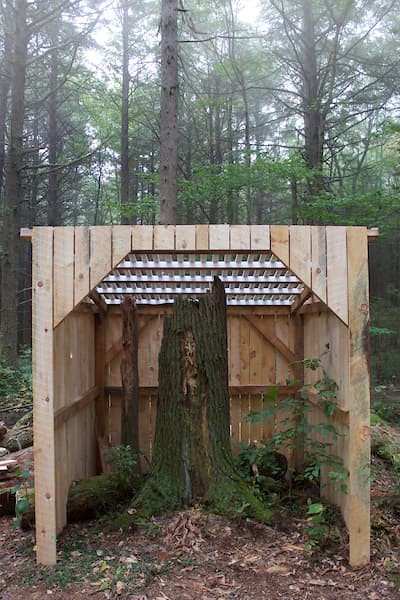
Hemlock Memorial Shed, installation at Harvard Forest, 8 x 8 x 9 feet, wood, acrylic paint, and assorted hardware, 2017. Collaborators: David Buckley Borden, Mike Demaggio, Aaron Ellison, CC McGregor, Jared Laucks, and Lisa Q Ward. Photograph © David Buckley Borden and used with permission.

David Buckley Borden, “Hemlock Memorial 2019,” digital drawing, 8 x 10 inches, 2017.
The Exchange Tree offers a similar opportunity for public mourning and continued remembrance. Tucked just slightly off of the viewing traill, the bright yellow that is found throughout the entire installation is hard to miss. Its presence is ominous, yet inviting, sitting just below a still-standing hemlock. Visitors are encouraged to leave notes on the constructed hemlock. In the spirit of Emily Dickinson and Robert Frost, who both penned famed poems about the Hemlock, a visitor wrote, “guard your heart from stone; you are sacred to our earth our home” and another, “I’m sorry for our ignorance and your destruction.”
“It is hubris to say that we are destroying the planet, he asserted, “When in reality we are destroying humanity. Nature doesn’t need humans. Nature always has been and always will be, regardless of whether humans are here or not.” When thinking about how to promote empathy towards the earth, this, he argues, is a more truthful starting point rather than theoretical, all encompassing solutions to global warming.
“To really halt global warming, there would have to be no economic growth,” he asserted. “It sounds great in the abstract, but even I don’t know one environmental biologist who was happy after the 2008 crash, when there was two full years of economic stagnation.” Ellison, who has worked among and with the hemlock species for over 30 years, holds a surprisingly pragmatic view of the situation.
However, Borden actively maintains optimism about reforming human behavior and reversing the effects of global warming. He hopes people walk away from the exhibit with newfound drive to adopt ethical habits. Little things like turning off your computer, he still believes, can have a huge impact.
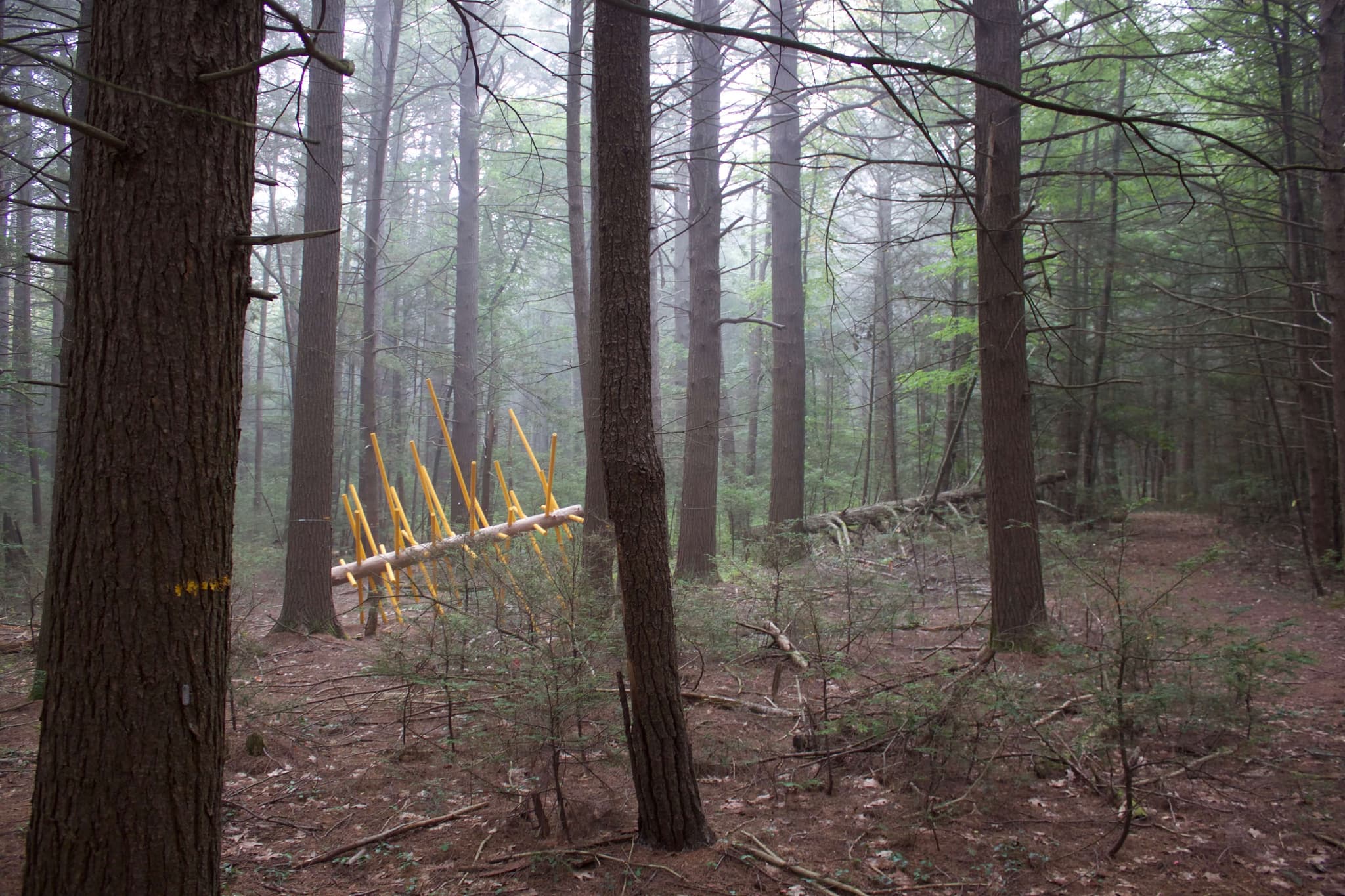
Exchange Tree, installation at Harvard Forest, 8 x 10 x 12.5 feet, wood and acrylic paint, 2017. Collaborators: David Buckley Borden, Aaron Ellison, Salvador Jiménez-Flores, and Salua Rivero. Photograph © David Buckley Borden and used with permission.
At first, it was tempting to categorize Borden as the hopeful artist, and Ellison as the practical scientist. But as the day unfolded, it became increasingly clear that such categorization reflected only a desire to create clear boundaries for what are always complicated identities. Hidden beneath a thin layer of ecological vocabulary and design thinking jargon is a shared love of exploring the world with fierce compassion and experimentation. As the installations developed, Ellison and Borden prioritized time for the contributing artists and scientists to discover their common ground. After long days of ideation and execution, everyone gathered around the fire and just talked. Artist to scientist; scientist to artist.
“Aaron Ellison is such an inspiration to me,” contributing artist Lisa Ward said. “He gave us a late night tour of the labs, and brought us in to see the Pitcher plant. He introduced me to this machine that analyzes different pigments through color and tells scientists information about chemicals, but through this color language. I mean, it’s beautiful. There is so much fodder for art everywhere you look there.”
Ward, an accomplished installation artist, believes the public has largely lost interest in natural processes. “Hemlock Hospice,” she thinks, has the potential to inspire local communities to find perspective and nuance in their ecological environments.
“It certainly took me quite some time to understand that referring to the adelgid as a bad phenomena is really just a human vantage point.” Ward said. “I think all of the scientists, but especially Dr. Ellison have this fundamental grasp on the fact that our place as humans in the greater process of nature is not necessarily a good or bad dichotomy. The ‘pest’ is as much an end as it as a beginning.”

David Buckley Borden, “Environmental Threat Level Sign,” design study for installation, recycled specimen box, fence posts, dowels, acrylic, vinyl, and hardware, .25 x 1.5 x 3 feet, 2017.
The reality is that the Eastern Hemlock is just one of many species facing extinction or significant loss around the world as part of the ongoing sixth extinction. At the end of the trail, a blue and white flag hangs with a bright red triangle in the center. We’ve learned from Borden that the triangle, or delta, always refers to change. The flag is quite blunt, both in composition and message. Six withered and fallen trees comprise the tally marks that note our fate. Human overpopulation and consumption threaten thousands of species, not least of which is humanity itself. When we think about the end of human civilization, we often ignore the mass extinctions that will precede it; the methodical disappearance of one species after another, the slow goodbyes.
Of course, it is easy to be consumed by fatalism, but that is not what the “Hemlock Hospice” project seeks to elicit. Rather, the project as a whole—lectures, cultural engagement, public programming, installations, and published research—creates a space for respectfully understanding the story of the hemlock, the hemlock wooly adelgid, and the surrounding environment with empathy.
Emily Dickinson once wrote, “I think the Hemlock likes to stand/upon a marge of snow/it suits its own austerity/and satisfies an awe.” A severe strength that once felt permanent, now lost.
I think the Hemlock liked to stand, too.
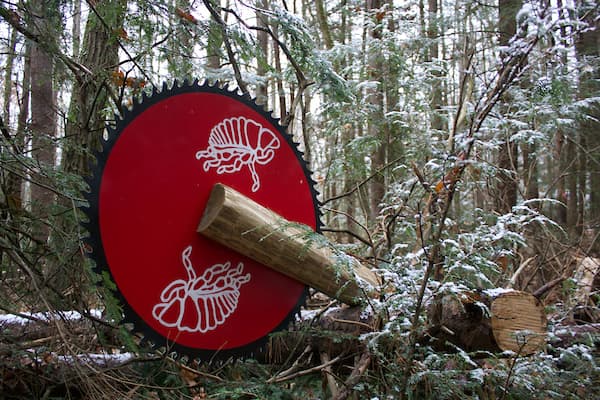
ouble Assault, installation at Harvard Forest, dimensions variable, acrylic paint, wood, vintage buzzsaws, and assorted hardware, 2017. Collaborators: David Buckley Borden, Jack K. Byers, Aaron Ellison, and Salua Rivero. Photograph © David Buckley Borden and used with permission.
The closing reception for the “Hemlock Hospice” art-science exhibition will be held on October 20th from 10am to 4pm at the Fisher Museum, Harvard Forest. Preview the “Hemlock Hospice” documentary here. This piece was originally published in Boston Art Review Magazine for Issue 02: Field Work.
